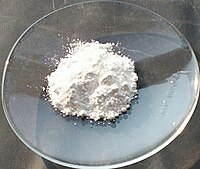
Photo from wikipedia
Abstract Iron oxide nanoparticles (Feox NPs) have been supported on the hydroxylated surface of modified diamond nanoparticles (D3). Characterization data show that, once formed, Fe NPs are spontaneously oxidized under… Click to show full abstract
Abstract Iron oxide nanoparticles (Feox NPs) have been supported on the hydroxylated surface of modified diamond nanoparticles (D3). Characterization data show that, once formed, Fe NPs are spontaneously oxidized under ambient conditions, exhibiting a good dispersion of small oxidized Feox NPs (2.2 ± 0.5 nm) on D3. It has been observed that the activity of Feox/D3 as heterogeneous Fenton catalyst for phenol degradation by H2O2 can be assisted by visible light irradiation. Feox/D3 exhibits a superior activity compared with analogous catalysts based on activated carbon, graphite or the benchmark Feox/TiO2 photocatalyst. Feox/D3 exhibits comparable activity to Ag/D3 that is one of the most active catalysts ever reported for this reaction. In addition, Feox/D3 presents higher stability and recyclability than analogous Cu/D3. A minimum accumulated turnover number of 38,000 can be achieved using Feox/D3 as photocatalyst. The heterogeneous photoFenton process using phenol as model pollutant and Feox/D3 as catalyst under visible light irradiation can be implemented prior to an aerobic biological treatment resulting in a biodegradable effluent which lacks ecotoxicity, as determined by measurement of the biological oxygen demand. Transient absorption spectroscopy provides evidence in support of the formation upon irradiation of Feox/D3 of photogenerated charge separation state attributed to electrons and holes. Electron paramagnetic resonance and selective quenching experiments indicate that hydroxyl radicals are the main reactive oxygen species generated in the photo-assisted Fenton reaction promoted by Feox/D3.
Journal Title: Applied Catalysis B: Environmental
Year Published: 2018
Link to full text (if available)
Share on Social Media: Sign Up to like & get
recommendations!